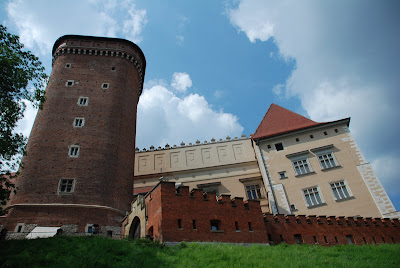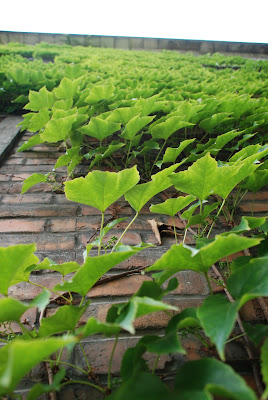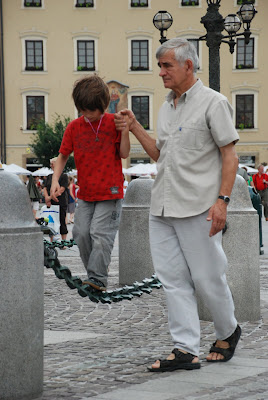______________________________

Krakow was the capital city of Poland prior to Warsaw, a historic town rich in heritage. The city did not suffer as badly as the other Polish cities during World War II, hence many of its buildings escaped from destruction. Despite so, they were in a state of neglect for many years, before being restored to their former splendour.

The Wawel Hill is one of the major attractions in Krakow. It used to be a royal residence, also housing a cathedral within the compound.

The entire Wawel Hill is surrounded by fortifications and towers, constructed from the 15th to the 19th centuries. The three towers are the dominant features of the architectural silhouette of Wawel.

Even with such complex defence system, the Wawel castle fell into dilapidation in the 18th century, only to be restored in the 20th century.

But it still ends up getting vandalised by people's declaration of love.

There's a story to the Wawel Hill. According to an old legend, the people of Krakow were terrorised by a dragon until one day, a brave shoemaker cheated the monster with a sheep stuffed with sulphur. The dragon swallowed the bait, and when the fire heated its gut, the dragon drank so much water from the Vistula River that its body burst.
There is a sculpture of the fire-belching dragon in the Dragon's Den, but unfortunately we didn't have the time to climb down the spiral steps leading down to the cave. But it is regarded as a popular attraction to visitors, especially the young ones.

The arcaded courtyard of the Wawel Royal Castle is of a beautiful Renaissance architecture. I love the fact that it's so spacious and airy, you could even hold a concert to hundreds of people there. :)

The castle is huge, and it displays a mixture of various architectural styles, that I couldn't identify which is which. haha.. But they are still as beautiful anyway. :)

Even if they got covered by the climbing greens. :)

The Krakow Cathedral is very strongly associated with the history of the city and the whole country. It served as the coronation site of nearly all Polish monarchs.

A monument of Pope John Paul II stands right outside of the Cathedral.

The exterior of the Cathedral seems.. towering. :) Although dating from different periods, the distinct parts of the Cathedral make a very unique ensemble.

The bones of an 'ancient creature' hang above the entrance of the Cathedral. According to legend, the end of the world will come when they fall. Hmm.. then how do they got hang up in the first place, if they weren't on the ground?

Our poor tour guide had to double up as the group's photographer when he himself suggested that we took a group photo near the Cathedral, because it was picturesque. Haha..

The Clock Tower is the tallest tower, with four statues of the patron saints of Poland and the Cathedral at each of the four corners. At the side of the tower stands the statue of Tadeusz Kościuszko, the general who lead the Insurrection of 1794 against the Russian army. His ashes rest in the crypt of the Cathedral.

When we were there at the Wawel Hill, there was a crowd, but it was still tolerable. Sometimes I do enjoy having a small crowd around, because there would be interesting observations.

But of course, without the crowd, it would be so much easier to capture the serenity of the place into photos. :)

Out of the Wawel Hill and into the Old Quarter of Krakow, I felt that the streets in the Old Quarter aren't as interesting as those in Warsaw.

Horse carriages are everywhere in the Old Quarter, very similar to the Old Town of Warsaw, and later I realised that horse carriages are a common sight in almost every Old Town of every city.

There are many churches in Krakow, and according to my guide book, there are some 40 churches within the historic centre alone. Wow. The larger churches have impressive interiors in various artistic styles.

The Franciscan Church presents a mix of Neo-Romanesque and Neo-Gothic style, after it has been rebuilt twice. The murals and the stained-glass windows add colours to the interior, something not commonly seen in many churches.

The Church of St Mary is situated in the Market Square. This Gothic basilica was the main parish church of Krakow's burghers. The Bugle-call Tower tips the church at 80 m tall, and on every hour a trumpeter plays the bugle call (hejnał) from this tower.

The hejnał used to serve as a warning against attacks by the Tartars. In the 13th century, a trumpeter was shot in the throat while sounding the alarm before the Mongol attack on the city. The plaintive tune breaks off in mid-stream, to commemorate him. The hejnał now acts as a greeting for visitors. Interesting.
And I was lucky to be able to hear it twice. :)
The church is renowned for its Gothic high altar, the largest in the world, carved by Veit Stoss between 1477 and 1489. The wooden altarpiece is 11 m long and 13 m high, and it's dedicated to the Assumption of the Virgin Mary.

We were lucky to be able to see the alterpiece with the shutters open. When it's closed, the panels show 12 scenes of the life of Jesus and Mary. Magnificent.
St Mary's Square, which is right beside the church, was once a graveyard but has been converted into a common walkway. A fountain with a figure of a student of medieval Karkow as the centrepiece stands in the middle of the walkway.

The most prominent buildings in the Market Square would be the Town Hall Tower and the Cloth Hall.

The Cloth Hall is an interesting building. Old as it may seem from the outside, which the side arcades echo the medieval architecture of Venice, it is lively inside. Originally a market hall, the Cloth Hall houses many stalls selling souvenirs, mostly wooden-carved figurines and other items. Many interesting finds in there. :)
The Market Square is vibrant and active. There was a crowd enjoying a puppet show, and a parade of old cars and interesting characters.

Even as the Market Square quietens down for a few moments, people get to enjoy their time spent at the square.

Dogs know how to enjoy their lazy afternoons too. :)

By the evening, the Market Square oozes a different kind of energy. As shops tend to close by then, pubs and cafes remain open, and a different kind of liveliness begins at the square.

One way of experiencing the different culture, is to eat in McDonald's. :) We all know that McDonald's is everywhere. It's a symbol of globalisation, but it's never really the same. They don't serve beef in Thailand, they don't serve pork in muslim countries.

In Krakow, they do serve prawn fritters. Never seen before in Singapore, or in Asia.

Salivating? Honestly, it was really yummy. :D
As the night falls, it marks the end of my stay in Poland. The country has left a good impression, and the people I've met there were simply great. Poland has never been any of my travel destination plans, but the rich heritage of the country and the beautiful sights have made it a place worth coming back again.

No comments:
Post a Comment